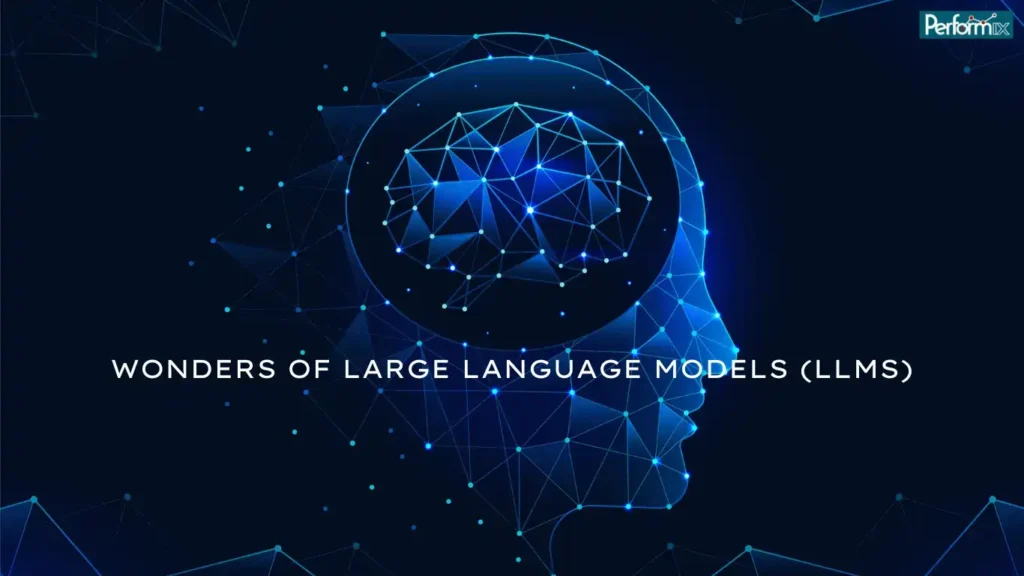In the ever-evolving landscape of artificial intelligence, Large Language Models (LLMs) have emerged as captivating entities, wielding the power to transform how we interact with language. These models, trained on vast textual datasets, possess an innate ability to predict and generate human-like text responses. But what exactly are LLMs, and why are they causing ripples in the tech world?
Understanding LLMs
At their core, LLMs are intricate machine-learning architectures designed to comprehend and generate text by learning intricate patterns and relationships within extensive training data. Their foundation lies in deep learning techniques, which enable them to process complex language structures. Imagine LLMs as language virtuosos, capable of deciphering context, mimicking style, and handling ambiguity while producing coherent and meaningful output. GPT-3 and GPT-4 from OpenAI, LLaMA from Meta, and PaLM2 from Google are some examples of LLMs.
Key Features of LLMs:
- Contextual Understanding:
LLMs exhibit an exceptional ability to seamlessly grasp the meaning and context of input prompts, allowing them to generate highly coherent and meaningful responses.
- Vast Knowledge Base:
With extensive training on massive textual datasets, LLMs provide accurate and informative answers to various queries.
- Style and Tone Mimicry:
LLMs generate text that mirrors the style and tone of their training data, resulting in an indistinguishably human-written output.
- Ambiguity Handling:
LLMs handle ambiguity and uncertainty in language by generating multiple plausible responses.
_Performix-blogs.png)
Applications of Large Language Models (LLMs) Across Sectors
Manufacturing Industry:
- Generative AI for Customer Experiences: LLMs are crucial in enhancing customer interactions. For instance:
- Personalization: LLMs enable personalized experiences by allowing end-customers to interact with systems using natural language prompts. Automotive OEMs can create smarter cockpits where comfort adjustments, route planning, and entertainment choices are executed through conversational features.
- Dealer Services: Instead of navigating different websites or making phone calls, vehicle owners could ask questions like, “When’s the next available appointment for routine maintenance near me?” LLMs facilitate seamless communication between customers and service providers.
- Shop Floor Productivity: LLMs empower shop floor workers to query complex systems (e.g., digital twins, control towers) without writing code or complex SQL queries. This accessibility improves responsiveness and productivity.
Healthcare:
- Medical Summarization: LLMs excel in creating concise summaries of medical records, research papers, and patient histories.
- Drug Discovery: LLMs analyze biomedical literature to identify potential drug candidates and explore novel therapeutic targets.
- Virtual Nursing Assistants: LLMs assist nurses by answering patient queries and providing personalized care recommendations.
- Clinical Documentation: LLMs improve the accuracy and efficiency of clinical documentation within Electronic Health Record (EHR) systems.
Education:
- Personalized Learning: LLMs enhance personalized learning experiences by adapting content to individual student needs.
- Automated Grading: LLMs assess student assignments, essays, and exams, providing instant feedback and reducing the burden on educators.
- Content Generation: LLMs create educational content, including lesson plans, lecture notes, and study guides.
Marketing:
- Content Creation: LLMs generate diverse written content, including blogs, articles, social media posts, and marketing copy.
- Idea Generation: Marketers use LLMs to brainstorm ideas, create compelling headlines, and develop creative campaigns.
- Sentiment Analysis: LLMs analyze customer reviews and social media posts to gauge sentiment and improve brand perception.
Legal:
- Legal Research and Analysis: LLMs assist legal professionals in researching case law, drafting legal documents, and analyzing competitors.
- Document Drafting: LLMs generate contracts, agreements, and legal briefs, saving time and ensuring accuracy.
- Compliance and Risk Assessment: LLMs analyze regulatory documents, identify compliance gaps, and assess business legal risks.
Other Practical Applications of LLMs:
- Translation: LLMs compete favorably in translating written texts into various languages, especially European languages.
- Malware Analysis: Google’s cybersecurity LLM, SecPaLM, aids in identifying malicious files without running them in a sandbox.

Listen to the latest podcast episode, “Decoding the Impact of AI on Jobs and Careers” exploring the future of work and career evolution with Sameer Ranjan.
Challenges Faced by LLMs:
- Scalability and Resource Intensiveness: Training and deploying large models demand substantial computational resources.
- Bias and Fairness: LLMs may inherit biases in the training data, resulting in biased outputs.
- Fine-Tuning and Customization: Adapting LLMs to specific domains or tasks requires meticulous fine-tuning and customization.
How do we overcome the challenges of deploying Large Language Models (LLMs) for industrial purposes?
Here are the answers. Start with.
1. Security and Privacy Concerns:
- On-Premises Deployment: Users can deploy LLMs within their environment, minimizing reliance on third-party endpoints. This approach ensures better control over data security and privacy.
- Open Source Models: Explore open-source LLMs (e.g., Llama2 and Falcon) that offer performance comparable to closed-source counterparts. Fine-tune these models based on relevant data for specific use cases.
2. Inference Challenges:
- Sequential Token Generation: Consider using asynchronous processing or batching requests to mitigate latency. Prioritize tasks based on their expected latency requirements.
- Variable-Sized Input Prompts: Optimize input prompts by balancing the trade-off between prompt length and model performance. Efficiently handle varying prompt lengths during inference.
- Low Batch Size: Experiment with batch sizes to find the right balance between computation and GPU utilization. Monitor IO bottlenecks and adjust accordingly.
3. Ambiguity Handling:
- Prompt Evaluation: Evaluate prompts to ensure the model understands examples and doesn’t overfit. Regularly update and optimize prompts to maintain performance and cost-effectiveness.
- Prompt Versioning: Maintain different versions of prompts to adapt to changing requirements and improve model behavior.
4. Cost and Latency Optimization:
- Cost Analysis: Continuously assess the cost implications of longer prompts and model outputs. Be aware that cost and latency considerations evolve rapidly in the LLM field.
- Prompt Tuning: Combine prompt-based approaches with fine-tuning to balance performance and resource efficiency.
5. Task Composability:
- Sequential Tasks: When deploying LLMs for multiple tasks, ensure task composability. LLM agents can control task flow, and incorporating tools or plugins allows efficient execution of specific actions.
6. User Experience and Monitoring:
- Monitoring and Mitigating Biases: Implement guidelines for responsible AI usage. Monitor and mitigate biases during training and fine-tuning processes.
- User Feedback Loop: Collect feedback to improve LLM behavior and address inconsistencies.
Implementing Large Language Models demands a comprehensive strategy, considering technical, operational, and ethical dimensions. Regularly evaluate and adjust your deployment approaches to align with emerging best practices and industry standards.
Embarking on the journey with Large Language Models (LLMs)
Here’s how you can start your LLM journey:
1. Define Clear Objectives
- Identify Use Cases: Begin by understanding your business needs. Which processes can benefit from LLMs? Consider customer support, content generation, data analysis, or compliance tasks.
- Set Goals: Define specific objectives. Are you aiming to improve response times, automate repetitive tasks, or enhance user experiences?
2. Explore Existing LLMs
- Research Available Models: Investigate pre-trained LLMs such as GPT-3, BERT, or RoBERTa. Understand their capabilities, strengths, and limitations.
- Choose Wisely: Select an LLM that aligns with your use cases. Some models excel in natural language understanding, while others are better at generation.
3. Data Preparation and Fine-Tuning
- Data Collection: Gather relevant data for fine-tuning. Curate a dataset that reflects your business context.
- Fine-tuning: Customize the LLM using your domain-specific data. Fine-tuning adapts the model to understand industry-specific jargon and nuances.
4. Integration and Deployment
- Infrastructure Setup: Ensure you have the necessary computational resources (CPU/GPU) and memory. Decide whether to deploy on-premises or in the cloud.
- API Integration: Integrate the LLM into your existing systems. Create APIs for seamless communication between your applications and the LLM.
5. Monitor and Iterate
- Performance Metrics: Define success metrics—accuracy, latency, user satisfaction, etc. Continuously monitor LLM performance.
- Feedback Loop: Collect user feedback. Adjust prompts, retrain, and fine-tune based on real-world interactions.
6. Responsible AI Practices
- Bias Mitigation: Be aware of biases present in training data. Regularly audit and address discrimination to ensure fair and ethical outcomes.
- Transparency: Document LLM behavior, prompt design, and decision-making processes. Transparency builds trust.
Remember that LLM adoption is an iterative process. Start small, learn from each step, and gradually expand your LLM applications. Seek expert guidance and collaborate with professionals who specialize in natural language processing. The journey with LLMs promises innovation, efficiency, and a competitive edge in today’s data-driven world.






